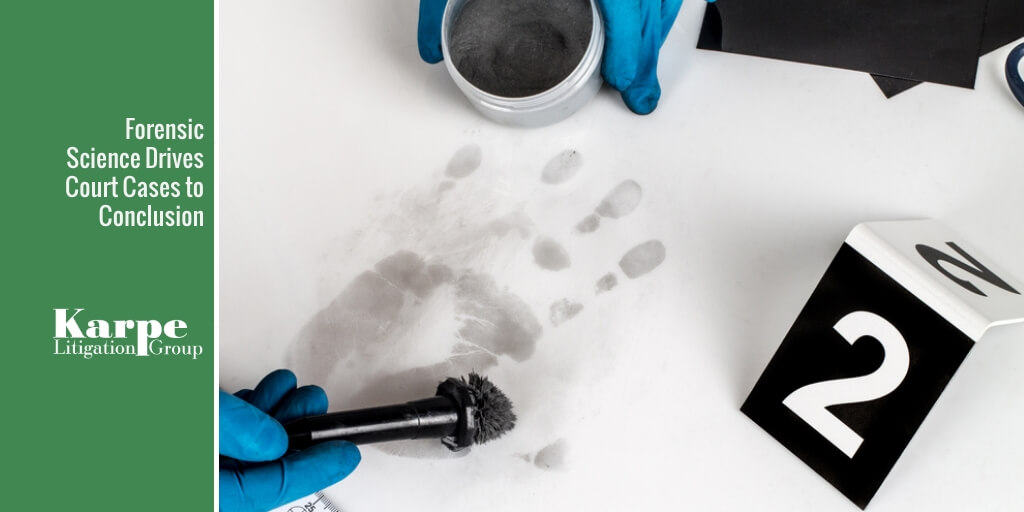
The forensic evidence left at a crime scene tells a very compelling story that is typically more reliable in court than witness testimony.
Most people are familiar with what happens during a court trial – we certainly watch enough law shows that give us an idea. When someone is charged with a crime, attorneys for the defense and the prosecution call witnesses to give testimony. The most compelling evidence may not come from a person, however. It comes from science. Forensic science.
Forensics Applies Scientific Principles and Techniques to Legal Problems
Forensic evidence is the information gathered about a crime using applied science. Investigators gather ballistics, hair and fiber samples, blood samples, tissue samples from under fingernails and all the things you typically see on your favorite crime drama that’s protected in plastic bags.
Forensic evidence is used in both civil and criminal cases to prove connections in court. Evidence like DNA is used to link crimes thought to be related or link a suspect of one crime to other crimes. This type of DNA linking helps law enforcement narrow down the pool of suspects, establishes patterns of crimes and helps speed the process of bringing criminals to justice.
Types of Forensic Evidence
Forensic scientists who process crime scenes are called crime scene investigators (CSIs). In Indiana, CSIs work with any law enforcement agency in the state and use the most up-to-date equipment and investigative methods available to them. The CSI will
- develop, secure and package physical evidence for scientific evaluation and comparison reconstruct the events that occurred during the commission of a crime
- prepare detailed reports of their observations and activities at the crime scene
- provide expert testimony in court regarding their findings and the methods used at the scene
In general, CSIs consider the following when gathering evidence:
Fragile or Transient Evidence
- Hairs, fibers, glass, fractured objects
- Shoe and tire impressions
- Barefoot impressions (latent)
- Barefoot impressions (in blood)
- Fire accelerants (point of origin)
- Body fluids (blood, semen, saliva)
- Skin cells (items touched or worn)
- Latent fingerprints
- Gunshot residue and patterns
Solid or Tangible Evidence
- Toolmarks (focus on point of entry)
- Firearms
- Other weapons (knives, clubs, etc.)
- Fired bullets
- Fired cartridge cases
- Unfired cartridges
- Drugs and paraphernalia
- Documents (checks, notes, receipts)
- Computers and devices
How Forensic Science Solves Crime
Think again of your favorite crime drama. When the CSIs arrive at the crime scene, they know not to disturb the scene until all possible forensic evidence is documented, photographed and gathered.
The evidence left at a crime scene tells a very compelling story that is typically more reliable than witness testimony. While forensic evidence can be used for nonviolent crime, such as computer hacking and fraud, it is most commonly used to solve more violent crimes – the types of crimes that leave a body or injure people, both physically and mentally.
The directionality of blood spatter can show where people were standing when the crime occurred. Trace fibers, hairs and other materials are gathered and sent back to the crime lab for analysis. DNA and dental records can be used for identifying a body.
Forensic science is not just used on bodies. Ballistics testing, also known as weapons testing, can yield valuable information about how a weapon was involved in a crime. Investigators can determine the specific make and model of a gun, where the shooter was standing and much more data about the weapon that can associate it with a particular person.
Forensic science plays a key role in cases of cybercrime. Circuits of phones and computers are traceable and digital footprints are left in databases and on servers that forensic scientists can use to track down cybercriminals.
How Forensic Evidence Is Used In Court
Forensic evidence is considered to be stronger and more reliable than evidence gathered from the testimony of witnesses, who could be swayed by one side or the other. The facts don’t lie and the science behind forensic evidence can show that.
However, if you must defend yourself for a crime, get legal representation with experience in the use of forensic evidence. As the prosecution is presenting their case, the validity of their forensic evidence can be questioned by a knowledgeable legal team that will ask, How was the evidence collected? Could tampering or contamination come to light? Could the chain of custody point to some other way the evidence has been compromised?
The Future of Forensic Science
Even though evidence such as fingerprints has been used for years to make a strong case and its scientific reliability is well established, evidence gathered scientifically through forensics must stand up to rigorous questioning before it is accepted as proof in a courtroom.
Over the past few decades, DNA evidence has proven its worth and is generally considered admissible. But the continual evolution of science means many new and untested technologies exist that have not yet proven their reliability in a court of law.
If one side in a trial asks to submit evidence that has not been proven over time and is not yet accepted by the scientific community, then the court will often order a mini-trial to review the validity of the scientific theory on which the evidence is based.
One technology currently going through the mini-trials process is functional Magnetic Resonance Imaging (fMRI). This technology is a new form of lie detection that works by imaging the flow of blood around the brain in order to detect when someone is lying. If a judge in a mini-trial can be convinced that this yet-to-be-proven technology should be introduced at trial, then it could become a new accepted piece of forensic evidence in the courtroom.
Personal Attention from Professional Attorneys
If you are accused of a crime, talk to the professional attorneys at Karpe Litigation Group today. We are experts in injury and accident law and use forensic evidence to win the most challenging cases, helping those in need for 20 years and counting. There is no fee until we win for you. Committed to making things easy for you, we are happy to meet by appointment on evenings and weekends, and travel to you when needed. Give us a call today at 1-888-228-7800 or fill out our contact form to schedule your free initial consultation.






